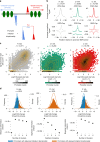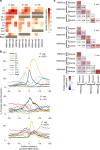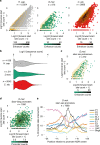Determinants of promoter and enhancer transcription directionality in metazoans
- PMID: 30367057
- PMCID: PMC6203779
- DOI: 10.1038/s41467-018-06962-z
Determinants of promoter and enhancer transcription directionality in metazoans
Abstract
Divergent transcription from promoters and enhancers is pervasive in many species, but it remains unclear if it is a general feature of all eukaryotic cis regulatory elements. To address this, here we define cis regulatory elements in C. elegans, D. melanogaster and H. sapiens and investigate the determinants of their transcription directionality. In all three species, we find that divergent transcription is initiated from two separate core promoter sequences and promoter regions display competition between histone modifications on the + 1 and -1 nucleosomes. In contrast, promoter directionality, sequence composition surrounding promoters, and positional enrichment of chromatin states, are different across species. Integrative models of H3K4me3 levels and core promoter sequence are highly predictive of promoter and enhancer directionality and support two directional classes, skewed and balanced. The relative importance of features to these models are clearly distinct for promoters and enhancers. Differences in regulatory architecture within and between metazoans are therefore abundant, arguing against a unified eukaryotic model.
Conflict of interest statement
The authors declare no competing interests.
Figures






Similar articles
-
Transcription start site analysis reveals widespread divergent transcription in D. melanogaster and core promoter-encoded enhancer activities.Nucleic Acids Res. 2018 Jun 20;46(11):5455-5469. doi: 10.1093/nar/gky244. Nucleic Acids Res. 2018. PMID: 29659982 Free PMC article.
-
Enhancer choice in cis and in trans in Drosophila melanogaster: role of the promoter.Genetics. 2004 Aug;167(4):1739-47. doi: 10.1534/genetics.104.026955. Genetics. 2004. PMID: 15342512 Free PMC article.
-
Transcriptional cofactors display specificity for distinct types of core promoters.Nature. 2019 Jun;570(7759):122-126. doi: 10.1038/s41586-019-1210-7. Epub 2019 May 15. Nature. 2019. PMID: 31092928 Free PMC article.
-
Divergent transcription and epigenetic directionality of human promoters.FEBS J. 2016 Dec;283(23):4214-4222. doi: 10.1111/febs.13747. Epub 2016 May 11. FEBS J. 2016. PMID: 27115538 Review.
-
Evaluating Enhancer Function and Transcription.Annu Rev Biochem. 2020 Jun 20;89:213-234. doi: 10.1146/annurev-biochem-011420-095916. Epub 2020 Mar 20. Annu Rev Biochem. 2020. PMID: 32197056 Review.
Cited by
-
Lessons from eRNAs: understanding transcriptional regulation through the lens of nascent RNAs.Transcription. 2020 Feb;11(1):3-18. doi: 10.1080/21541264.2019.1704128. Epub 2019 Dec 19. Transcription. 2020. PMID: 31856658 Free PMC article. Review.
-
Transcription Factors Drive Opposite Relationships between Gene Age and Tissue Specificity in Male and Female Drosophila Gonads.Mol Biol Evol. 2021 May 4;38(5):2104-2115. doi: 10.1093/molbev/msab011. Mol Biol Evol. 2021. PMID: 33481021 Free PMC article.
-
Crosstalk between chromatin and Shavenbaby defines transcriptional output along the Drosophila intestinal stem cell lineage.iScience. 2023 Dec 3;27(1):108624. doi: 10.1016/j.isci.2023.108624. eCollection 2024 Jan 19. iScience. 2023. PMID: 38174321 Free PMC article.
-
Dissecting the cis-regulatory syntax of transcription initiation with deep learning.bioRxiv [Preprint]. 2024 Nov 21:2024.05.28.596138. doi: 10.1101/2024.05.28.596138. bioRxiv. 2024. PMID: 38853896 Free PMC article. Preprint.
-
Eutherian-Specific Gene TRIML2 Attenuates Inflammation in the Evolution of Placentation.Mol Biol Evol. 2020 Feb 1;37(2):507-523. doi: 10.1093/molbev/msz238. Mol Biol Evol. 2020. PMID: 31633784 Free PMC article.
References
Publication types
MeSH terms
Substances
Grants and funding
LinkOut - more resources
Full Text Sources
Molecular Biology Databases

